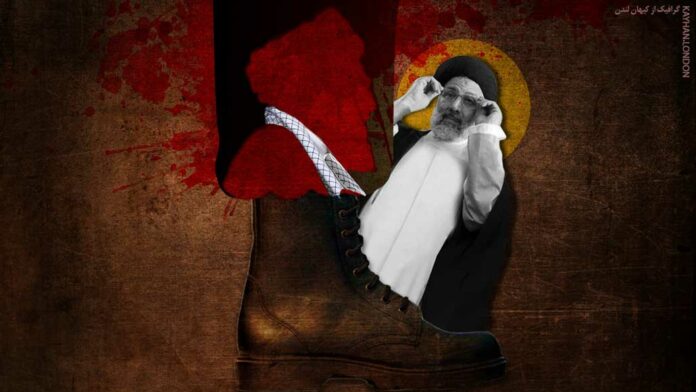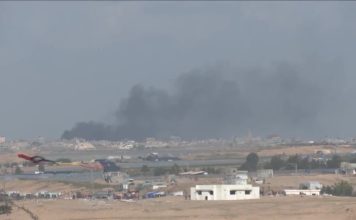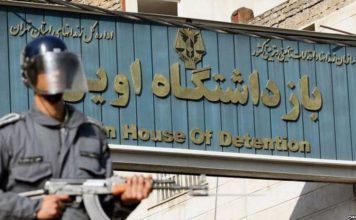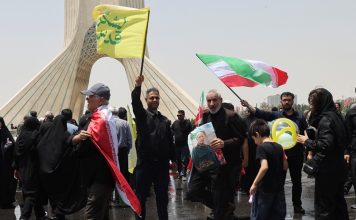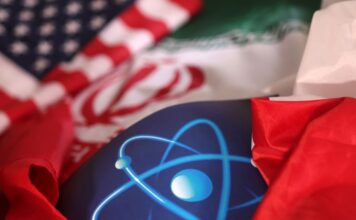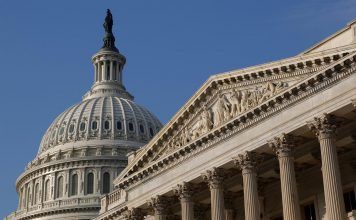By Michael Georgy and Tom Perry
DUBAI, Oct 25 (Reuters) – By tightening curbs on women’s rights, President Ebrahim Raisi has boosted his hardline credentials and possibly his prospects of becoming Iran‘s Supreme Leader, even at the cost of provoking mass protests and driving a wedge between many Iranians and the ruling elite, three analysts and a pro-reform official said.
A year after Raisi’s election marked the end of what many Iranians recall as more pragmatic, tolerant times, his government’s tougher enforcement of hijab wearing in the weeks before Mahsa Amini’s death in custody on Sept. 16 reflected a full reassertion of hardline influence.
Iran Accused of “Crimes Against Humanity” at Aban Tribunal in London
Now, as tens of thousands of protesters call for the Islamic Republic’s downfall in response to Amini’s death, the hardliners appear to be doubling down, backing their ally Raisi’s use of force against the demonstrations, even if policy rests firmly in the hands of Supreme Leader Ayatollah Ali Khamenei.
The backdrop is what analysts and insiders close to Iran‘s decision-makers see as the determination of Khamenei, 83, to shore up the pillars of the Islamic Republic he has led since the death of its founder, Ayatollah Ruhollah Khomeini, in 1989.
SPECIAL REPORT- Iran’s Leader Ordered Crackdown on Unrest: “Do Whatever It Takes to End It”
Raisi, an outspoken champion of Iran‘s system of clerical rule, is widely seen by ordinary Iranians, foreign experts and clerical insiders as a contender to succeed Khamenei, even though he has not publicly declared that ambition. The supreme leader has not endorsed a successor and others are also seen to be in the picture, most notably Khamenei’s son Mojtaba.
“Raisi truly believes in the supreme leader’s revolutionary agenda. He is a hardliner who believes in stricter social and political limitations,” said a pro-reform official, speaking on condition of anonymity because of the political sensitivities.
“I don’t know whether he has personal ambitions to become the next supreme leader, but whether he succeeds the leader or not, let me underline that Raisi himself is an anti-Western cleric that does not believe in a freer society.”
Reuters could not reach officials at the offices of Raisi and Khamenei for comment.
A Khamenei protege, Raisi was elected president in June 2021 in a tightly managed race that brought all branches of the state under hardline control after years of more pragmatic government under ex-president Hassan Rouhani.
Raisi is trusted by the elite Revolutionary Guards, a hardline military force used by the state to violently crush political unrest over the decades, and seen by Iranians as an influential voice in determining the succession to Khamenei.
Appointed by Khamenei to the high-profile job of judiciary chief in 2019, Raisi was placed under U.S. sanctions a few months later over the role he allegedly played in the executions of thousands of political prisoners in 1988. Iran has never acknowledged the killings. Asked about the deaths at a June 2021 news conference, Raisi replied that a judge or prosecutor who defended people’s security should be praised.
UN Urged to Open Query Into Iran’s 1988 Killings and Raisi Role
‘HIJAB AND CHASTITY’
An order by Raisi in July that authorities must enforce Iran‘s “hijab and chastity law” resulted in more restrictions, such as women being banned from entering some banks, government offices and some forms of public transportation.
Then in Tehran, on Sept. 13, morality police arrested Amini – an Iranian Kurd – for “inappropriate attire”. Three days later, she died in a hospital in the capital after falling into a coma. Referring to the day Amini collapsed in custody, the coroner said she had briefly regained consciousness but that “cardio-respiratory resuscitation was ineffective in the first critical minute, resulting in brain damage.”
The family deny the 22-year-old had any heart problems.
Iran’s President Raisi Calls for Enforcement of ‘Hijab and Chastity Law’
Women have torn off and burned headscarves during the protests ignited by her death, one of the boldest popular revolts since the 1979 revolution and a symbolic blow against the Islamic Republic, which has sought to impose conservative dress codes on women in public.
“While succession is always in the background of Iranian politics, I view the intensified focus on hijab, which began in earnest this summer, as more a reflection of the unification of hardline power,” said Henry Rome of the Washington Institute for Near East Policy think tank.
The stepped up enforcement under Raisi marked a break not only with Rouhani’s times, but also the presidency of Mahmoud Ahmadinejad, who was known as a hardliner on many issues but resisted strict imposition of dress codes.
“Khamenei is preparing. He wants to leave a legacy, and his legacy should be a strengthening of the Islamic Republic, which translates into a hardening of its internal fabric,” said Cornelius Adebahr of the Carnegie Endowment for International Peace.
Kayhan Life Interviews Revolutionary Guard Opposing Islamic Republic
IRGC Trains Minors as Riot Police Without Parental Consent, Report Says
While the protests have triggered questions over the hijab enforcement policy from some officials – Khamenei adviser Ali Larijani notably asked whether police should be imposing the headscarf at all – hardliners have been unbending.
Interior minister Ahmad Vahidi, a former Revolutionary Guards’ commander, has accused protesters of creating “hideous scenes” in the name of women’s rights, saying protesters saw “freedom in the nakedness and shamelessness of women”.
The Guards are expected to have a big say over the succession, with the next supreme leader more reliant on their support in the face of anti-government dissent, said Kasra Aarabi, Iran Programme Lead at the Tony Blair Institute.
‘RAISI GET LOST’
The Guards are also likely to play a major role if Iran decides on all-out repression of the unrest, in which more than 200 people have already been killed, according to rights groups.
But the succession has complicated the leadership’s thinking about how tough a crackdown needs to be, since the start of the unrest coincided with rumours about Khamenei’s ailing health, three analysts and an official told Reuters in September.
The establishment – a dual system of clerical authority and an elected president and parliament – has been preoccupied with manoeuvring linked to the succession even as it weighs security policy.
Some insiders fear that using more force might expose divisions within its ranks while fuelling more unrest, something it can ill-afford at such a sensitive time, the analysts and official said in September.
Raisi encountered protesters’ anger himself during a visit to a Tehran university this month, where female students chanted “Raisi get lost” and “Mullahs get lost”.
[aesop_image img=”https://kayhanlife.com/wp-content/uploads/2018/11/2000-05-24T120000Z_290008275_RP2DRIBIJIAA_RTRMADP_3_IRAN-REFORM.jpg” panorama=”off” credit=”FILE PHOTO: A student from Tehran university holds a placard calling for democracy in Iran. Reuters./” align=”center” lightbox=”on” captionsrc=”custom” captionposition=”left” revealfx=”off” overlay_revealfx=”off”]
Echoing Khamenei, Raisi has repeatedly sought to blame the West for the unrest, accusing U.S. President Joe Biden of sowing “chaos, terror, and destruction”, and citing Khomeini’s description of the United States as “the great satan”.
On Raisi’s watch, months of indirect talks between Iran and the United States in Vienna on salvaging a 2015 nuclear deal have stalled. Both sides say political decisions are required by Tehran and Washington to settle the remaining issues.
Sanctions on Iranian oil have continued to squeeze Iran‘s economy, driving the currency to record lows.
Meir Javedanfar, Iran Lecturer at Reichman University in Israel, said: “Raisi is taking such an extreme position on women’s rights because he knows this is what Khamenei wants.”
“Following Khamenei’s position on women’s issue would keep him in the race to replace Khamenei.”
ANALYSIS: Women-Led Protests Are Shifting the West’s Attitude Towards Iran
(Additional reporting by Michael Georgy in Dubai and Tom Perry in Beirut; Writing by Tom Perry, Editing by William Maclean)

